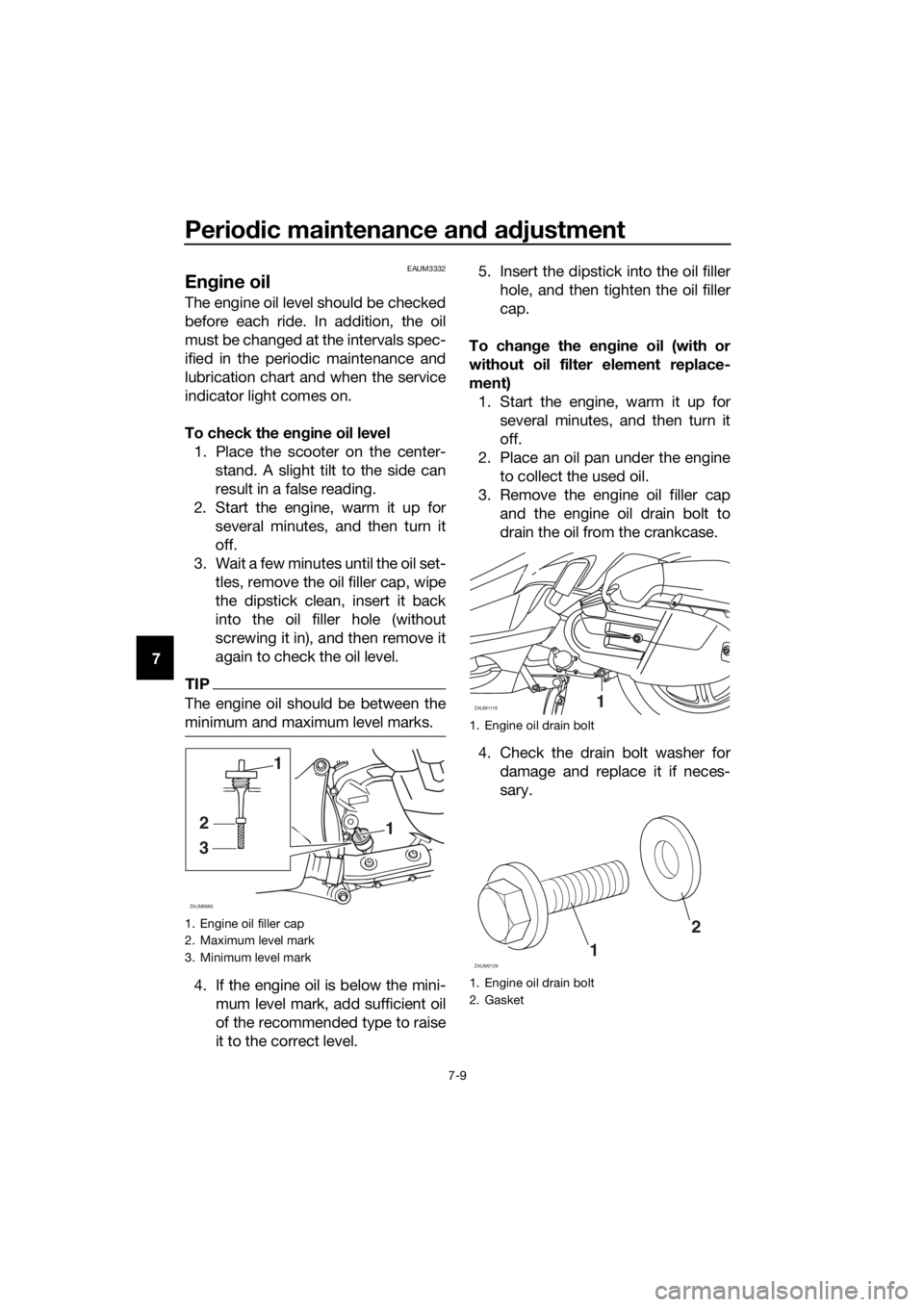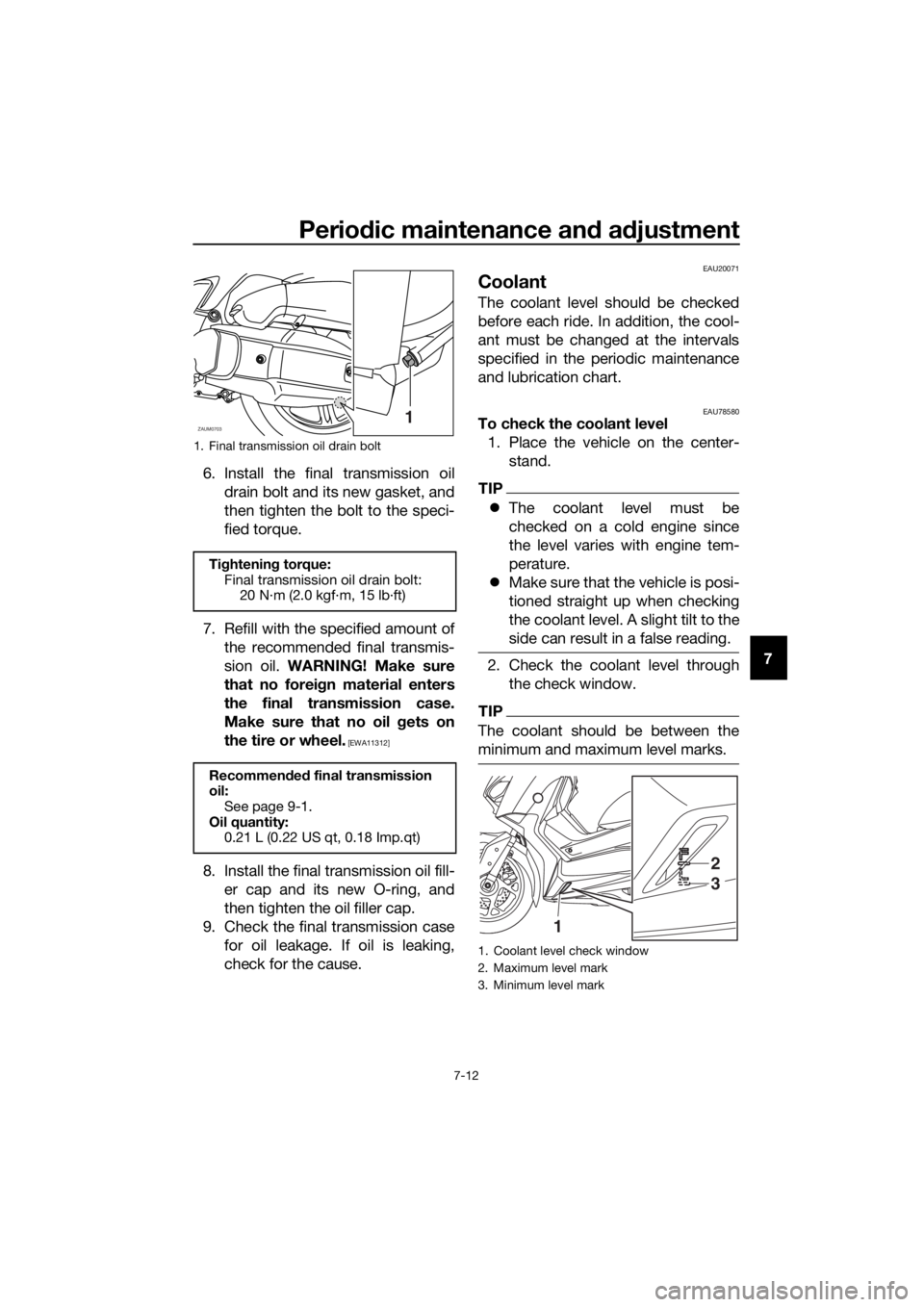Page 72 of 114

Periodic maintenance and adjustment
7-9
7
EAUM3332
Engine oil
The engine oil level should be checked
before each ride. In addition, the oil
must be changed at the intervals spec-
ified in the periodic maintenance and
lubrication chart and when the service
indicator light comes on.
To check the engine oil level
1. Place the scooter on the center-
stand. A slight tilt to the side can
result in a false reading.
2. Start the engine, warm it up for
several minutes, and then turn it
off.
3. Wait a few minutes until the oil set-
tles, remove the oil filler cap, wipe
the dipstick clean, insert it back
into the oil filler hole (without
screwing it in), and then remove it
again to check the oil level.
TIP
The engine oil should be between the
minimum and maximum level marks.
4. If the engine oil is below the mini-
mum level mark, add sufficient oil
of the recommended type to raise
it to the correct level.5. Insert the dipstick into the oil filler
hole, and then tighten the oil filler
cap.
To change the engine oil (with or
without oil filter element replace-
ment)
1. Start the engine, warm it up for
several minutes, and then turn it
off.
2. Place an oil pan under the engine
to collect the used oil.
3. Remove the engine oil filler cap
and the engine oil drain bolt to
drain the oil from the crankcase.
4. Check the drain bolt washer for
damage and replace it if neces-
sary.
1. Engine oil filler cap
2. Maximum level mark
3. Minimum level mark
1
3
2
1
ZAUM0685
1. Engine oil drain bolt
1. Engine oil drain bolt
2. Gasket
ZAUM11191
1
2
ZAUM0129
UBL2E0E0.book Page 9 Friday, June 23, 2017 9:30 AM
Page 75 of 114

Periodic maintenance and adjustment
7-12
7 6. Install the final transmission oil
drain bolt and its new gasket, and
then tighten the bolt to the speci-
fied torque.
7. Refill with the specified amount of
the recommended final transmis-
sion oil. WARNING! Make sure
that no foreign material enters
the final transmission case.
Make sure that no oil gets on
the tire or wheel.
[EWA11312]
8. Install the final transmission oil fill-
er cap and its new O-ring, and
then tighten the oil filler cap.
9. Check the final transmission case
for oil leakage. If oil is leaking,
check for the cause.
EAU20071
Coolant
The coolant level should be checked
before each ride. In addition, the cool-
ant must be changed at the intervals
specified in the periodic maintenance
and lubrication chart.
EAU78580To check the coolant level
1. Place the vehicle on the center-
stand.
TIP
The coolant level must be
checked on a cold engine since
the level varies with engine tem-
perature.
Make sure that the vehicle is posi-
tioned straight up when checking
the coolant level. A slight tilt to the
side can result in a false reading.
2. Check the coolant level through
the check window.
TIP
The coolant should be between the
minimum and maximum level marks.
1. Final transmission oil drain bolt
Tightening torque:
Final transmission oil drain bolt:
20 N·m (2.0 kgf·m, 15 lb·ft)
Recommended final transmission
oil:
See page 9-1.
Oil quantity:
0.21 L (0.22 US qt, 0.18 Imp.qt)
ZAUM07031
1. Coolant level check window
2. Maximum level mark
3. Minimum level mark
1
2
3
UBL2E0E0.book Page 12 Friday, June 23, 2017 9:30 AM
Page 91 of 114

Periodic maintenance and adjustment
7-28
7
If a fuse is blown, replace it as follows.
1. Turn the main switch off and turn
off the electrical circuit in ques-
tion.
2. Remove the blown fuse, and then
install a new fuse of the specified
amperage. WARNING! Do not
use a fuse of a higher amperage
rating than recommended to
avoid causing extensive dam-
age to the electrical system and
possibly a fire.
[EWA15132]
3. Turn the main switch on and turn
on the electrical circuit in question
to check if the device operates.
4. If the fuse immediately blows
again, have a Yamaha dealer
check the electrical system.
1. Signaling system fuse 2
2. Signaling system fuse
3. ABS control unit fuse
4. Main fuse 2
5. Radiator fan motor fuse
6. Backup fuse
7. Spare fuse
8. ABS motor fuse
9. ABS solenoid fuse
10.Turn signal light and hazard fuse
11.Terminal fuse 1 (for auxiliary DC jack)
12.Answer back fuse
ZAUM1529
1234567
8910
11
7
Specified fuses:
Main fuse:
20.0 A
Main fuse 2:
7.5 A
Terminal fuse 1:
2.0 A
Signaling system fuse:
10.0 A
Signaling system fuse 2:
7.5 A
Radiator fan motor fuse:
7.5 A
Backup fuse:
7.5 A
Turn signal light and hazard fuse:
7.5 A
ABS control unit fuse:
7.5 A
ABS motor fuse:
30.0 A
ABS solenoid fuse:
15.0 A
Answer back fuse:
2.0 A
UBL2E0E0.book Page 28 Friday, June 23, 2017 9:30 AM
Page 92 of 114
Periodic maintenance and adjustment
7-29
7
EAU64070
Headlights
This model is equipped with LED-type
headlights.
If a headlight does not come on, have
a Yamaha dealer check its electrical
circuit.
NOTICE
ECA16581
Do not affix any type of tinted film or
stickers to the headlight lens.
EAU54502
Auxiliary lights
This model is equipped with LED-type
auxiliary lights.
If an auxiliary light does not come on,
have a Yamaha dealer check it.
UBL2E0E0.book Page 29 Friday, June 23, 2017 9:30 AM
Page 93 of 114
Periodic maintenance and adjustment
7-30
7
EAU70540
Brake/tail light
This model is equipped with an LED-
type brake/tail light.
If the brake/tail light does not come on,
have a Yamaha dealer check it.
EAU39881
Front turn signal light
If a front turn signal light does not
come on, have a Yamaha dealer check
its electrical circuit or replace the bulb.
UBL2E0E0.book Page 30 Friday, June 23, 2017 9:30 AM
Page 94 of 114
Periodic maintenance and adjustment
7-31
7
EAUT1331
Rear turn signal light bulb
If a rear turn signal light does not come
on, have a Yamaha dealer check the
electrical circuit or replace the bulb.
EAU78560
Replacing the license plate
light bulb
1. Remove the license plate light unit
by removing the bolts and plate,
and then remove the license plate
light bulb socket (together with the
bulb) by pulling it out.
2. Remove the burnt-out bulb by
pulling it out.
3. Insert a new bulb into the socket.
4. Install the socket (together with
the bulb) by pushing it in, and then
install the license plate light unit by
installing the plate and bolts.
1. License plate light unit
2. Bolt
3. Nut
4. License plate light bulb socket
1. License plate light bulb
ZAUM1538
1 4
3
2
ZAUM1539
1
UBL2E0E0.book Page 31 Friday, June 23, 2017 9:30 AM
Page 95 of 114

Periodic maintenance and adjustment
7-32
7
EAU60701
Troubleshooting
Although Yamaha vehicles receive a
thorough inspection before shipment
from the factory, trouble may occur
during operation. Any problem in the
fuel, compression, or ignition systems,
for example, can cause poor starting
and loss of power.
The following troubleshooting charts
represent quick and easy procedures
for checking these vital systems your-
self. However, should your vehicle re-
quire any repair, take it to a Yamaha
dealer, whose skilled technicians have
the necessary tools, experience, and
know-how to service the vehicle prop-
erly.
Use only genuine Yamaha replace-
ment parts. Imitation parts may look
like Yamaha parts, but they are often
inferior, have a shorter service life and
can lead to expensive repair bills.
WARNING
EWA15142
When checking the fuel system, do
not smoke, and make sure there are
no open flames or sparks in the ar-
ea, including pilot lights from water
heaters or furnaces. Gasoline or
gasoline vapors can ignite or ex-
plode, causing severe injury or prop-
erty damage.
EAU76551Smart key system troubleshooting
Please check the following items when
the smart key system does not work.
Is the smart key turned on? (See
page 3-5.)
Is the smart key battery dis-
charged? (See page 3-6.)Is the smart key battery installed
correctly? (See page 3-6.)
Is the smart key being used in a lo-
cation with strong radio waves or
other electromagnetic noise? (See
page 3-1.)
Are you using the smart key that is
registered to the vehicle?
Is the vehicle battery discharged?
When the vehicle battery is dis-
charged, the smart key system will
not operate. Please have the vehi-
cle battery charged or replaced.
(See page 7-26.)
If the smart key system does not work
after checking the above items, have a
Yamaha dealer check the smart key
system.
TIP
See Emergency mode on page 7-35
for information on starting the engine
without the smart key.
UBL2E0E0.book Page 32 Friday, June 23, 2017 9:30 AM
Page 98 of 114

Periodic maintenance and adjustment
7-35
7
EAU76561
Emergency mode
When the smart key is lost or dam-
aged, or its battery has discharged, the
vehicle can still be turned on and the
engine started. You will need the smart
key system identification number.
To operate the vehicle in emergency
mode
1. Stop the vehicle in a safe place
and turn the main switch to “OFF”.
2. Push the main switch knob for 5
seconds until the smart key sys-
tem indicator light flashes once,
then release it. Repeat two more
times. The smart key system indi-
cator light will come on for three
seconds to indicate the transition
to emergency mode.
3. After the smart key system indica-
tor light goes off, input the identifi-
cation number as follows.4. Inputting the identification number
is done by counting the number of
flashes of the smart key system in-
dicator light.
For example, if the identification
number is 123456:
Push and hold the knob.
↓
The smart key system indicator
light will start to flash.
↓
Release the knob after the smart
key system indicator light flashes
once.
↓
The first digit of the identification
number has been set as “1”.
↓
Push and hold the knob again.
↓
1. Smart key system indicator light “ ”
ZAUM15301
1. Identification number card
2. Smart key (inside)
3. Identification number
868588
868588
1
32
UBL2E0E0.book Page 35 Friday, June 23, 2017 9:30 AM